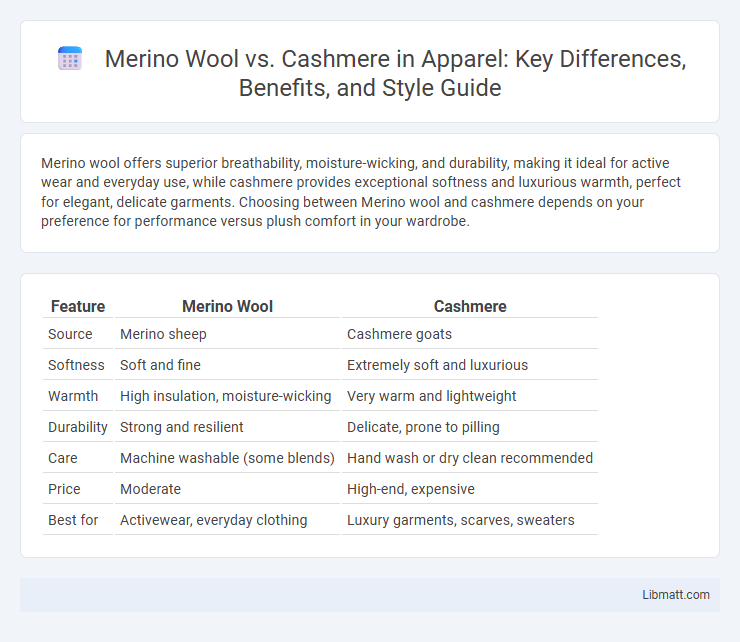Merino wool offers superior breathability, moisture-wicking, and durability, making it ideal for active wear and everyday use, while cashmere provides exceptional softness and luxurious warmth, perfect for elegant, delicate garments. Choosing between Merino wool and cashmere depends on your preference for performance versus plush comfort in your wardrobe.
Table of Comparison
| Feature | Merino Wool | Cashmere |
|---|---|---|
| Source | Merino sheep | Cashmere goats |
| Softness | Soft and fine | Extremely soft and luxurious |
| Warmth | High insulation, moisture-wicking | Very warm and lightweight |
| Durability | Strong and resilient | Delicate, prone to pilling |
| Care | Machine washable (some blends) | Hand wash or dry clean recommended |
| Price | Moderate | High-end, expensive |
| Best for | Activewear, everyday clothing | Luxury garments, scarves, sweaters |
Introduction to Merino Wool and Cashmere
Merino wool, sourced from Merino sheep primarily in Australia and New Zealand, offers exceptional softness, breathability, and moisture-wicking properties, making it ideal for performance and everyday wear. Cashmere, harvested from the undercoat of Cashmere goats mainly in Mongolia and China, is celebrated for its luxurious softness, lightweight warmth, and insulating qualities. Both fibers provide premium comfort but differ in origin, texture, and common uses within the textile industry.
Origins and Source of Each Fiber
Merino wool originates from Merino sheep primarily raised in Australia and New Zealand, prized for their fine, soft fibers that offer excellent breathability and moisture-wicking properties. Cashmere is sourced from the undercoat of Cashmere goats mainly found in Mongolia, China, and parts of Central Asia, valued for its luxurious softness and insulating warmth. Your choice between these fibers depends on whether you prioritize durability and moisture management or supreme softness and thermal insulation.
Texture and Softness Comparison
Merino wool features a fine, smooth texture with fibers typically ranging from 15 to 24 microns, making it soft yet durable and breathable. Cashmere boasts an even finer fiber diameter, usually between 14 and 19 microns, resulting in an exceptionally soft and luxurious feel that's warmer and lighter than merino wool. When choosing your ideal fabric for garments, consider that cashmere provides superior softness and warmth, while merino wool offers better moisture-wicking and resilience.
Warmth and Insulation Properties
Merino wool provides excellent warmth and moisture-wicking insulation due to its fine fibers and natural crimp, which trap heat effectively while allowing breathability. Cashmere offers superior softness with a lightweight warmth thanks to its finer, hollow fibers that provide exceptional insulation by retaining body heat without bulk. Both fibers excel in temperature regulation, but cashmere generally delivers a warmer feel in colder conditions, while merino wool performs better during active wear with its moisture management capabilities.
Breathability and Moisture Management
Merino wool excels in breathability and moisture management due to its fine, natural fibers that wick moisture away from the skin while allowing airflow, keeping the wearer dry and comfortable in various conditions. Cashmere, made from the soft undercoat of cashmere goats, offers moderate breathability but retains more moisture, which can lead to less effective moisture management compared to merino wool. For activewear and outdoor clothing, merino wool's superior breathability and moisture-wicking properties make it the optimal choice over cashmere.
Durability and Longevity
Merino wool offers superior durability and longevity compared to cashmere due to its fine, resilient fibers that resist pilling and wear over time. Cashmere, while luxuriously soft, is more delicate and prone to damage from friction and improper care. Choosing merino wool ensures your garments maintain their shape and quality through extended use, making it a practical investment for long-lasting comfort.
Care and Maintenance Requirements
Merino wool requires gentle hand washing or machine washing on a delicate cycle with cold water, and it should be air-dried flat to maintain its softness and elasticity. Cashmere demands even more delicate care, including hand washing with mild detergent or dry cleaning, avoiding wringing or twisting to prevent fiber damage. Proper care extends the life of your garments and preserves the luxurious texture of both merino wool and cashmere.
Sustainability and Ethical Considerations
Merino wool is often praised for its sustainability due to sheep being renewable resources that graze naturally, with many producers adopting responsible land management and animal welfare practices. Cashmere, derived from the undercoat of goats, faces challenges such as overgrazing and desertification, which raise concerns about its environmental impact and the ethical treatment of goats. Sustainable certifications and transparent supply chains are critical for both fibers to ensure ethical sourcing and reduced ecological footprints in the textile industry.
Price and Value Differences
Merino wool is generally more affordable than cashmere due to the higher availability and faster production cycles of merino sheep compared to cashmere goats. While cashmere commands a premium price for its exceptional softness and insulation, merino wool offers durable warmth and moisture-wicking properties at a better value. Consumers often choose merino wool for cost-effective performance in everyday wear, whereas cashmere is preferred for luxury and finer texture despite the higher cost.
Choosing Between Merino Wool and Cashmere
Choosing between Merino wool and cashmere depends on your needs for softness, warmth, and durability. Merino wool offers excellent moisture-wicking and temperature regulation, making it ideal for activewear or layering. Cashmere provides luxurious softness and superior insulation, perfect for elegant and cozy winter garments.
merino wool vs cashmere Infographic

 libmatt.com
libmatt.com